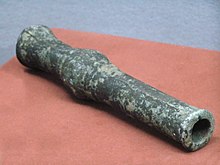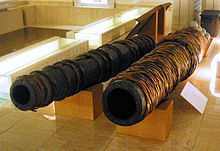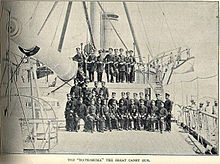Artillery of Japan

The use of artillery in Japan was initiated during the Sengoku period in the 16th century and developed thereafter until the present.
13th to 17th century

Due to its proximity with China, Japan had long been familiar with gunpowder. Primitive cannons seem to have appeared in Japan around 1270, as simple metal tubes invented in China and called Tetsuhō (鉄砲 Lit. "Iron cannon") seem to have been introduced in Japan as well. They don't seem to have been used extensively however, and cannon usage would only become major after the arrival of the Europeans in 1547.[1]

A few light cannon pieces were used at the Battle of Nagashino in 1575, but the first cannons entirely made by the Japanese were cast a few months after the battle. They were bronze two-pounders, about 9 feet long, and were delivered to the warlord Oda Nobunaga.[2]

Most of the first Japanese guns were provided by the "Nanban" Portuguese, but during that period guns are also known to have been supplied by the Dutch. Nineteen bronze cannons of the Dutch ship Liefde, piloted by William Adams were unloaded and according to Spanish accounts later employed at the decisive Battle of Sekigahara on October 21, 1600.
Quick-firing breech-loading swivel guns, were also used and manufactured by Japan. Such guns were in use in Western warships, and mounted at the bow and sterns to devastating effect, but the Japanese used them also in fortifications.[3]
After 1601 and the reunification of Japan under Tokugawa Ieyasu and the establishment of the Tokugawa Shogunate, a policy of seclusion was progressively enforced, leading to the expulsion of foreigner and the interdiction of trade with Western countries other than the Dutch from 1631. Afterwards and for about 200 years, weapon development remained at a standstill, and only a minimal amount of antiquated artillery pieces were maintained in coastal areas.
Late Tokugawa period



During the Late Tokugawa period, Japan intensified its efforts at protecting the coasts through artillery.
In 1841 Takashima Shūhan made a firearms and artillery demonstration to the Shogunate with 125 men, using Dutch Rangaku texbooks and Dutch commands for drilling.[4] He demonstrated the use of 4 cannons and 50 Western guns.[5]
Western domain such as Satsuma Domain, started to build modern cannons in the early part of the century.[6] Throughout Japan, cannons were installed all along the seashore, smoothbores firing round shots. Archaic technologies sometimes remained, as wooden cannon were sometimes still in use around 1854.[7] Defensive forts were built, such as the one protecting Edo at Odaiba, established in 1853–54 to prevent intrusions by American Commodore Perry.
During the conflicts of the Late Tokugawa period, Japanese antiquated cannon forces repeatedly fought against Western ships equipped with recently developed Paixhans shells, leading to systematic inferiority on the Japanese side. At the 1863 Bombardment of Kagoshima, a British fleet destroyed the city of Kagoshima, while the Japanese Satsuma forces ineffectively fired round cannon balls at the ships. At the Battle of Shimonoseki in 1863–64, large batteries of classical cannons belonging to Chōshū Domain were captured by a Western fleet as well.
Boshin war


After these conflicts, Japanese domains would progressively equip themselves with more modern artillery, especially howitzers firing explosive shells, which were imported from foreign countries. These weapons would be used decisively during the 1867–1869 Boshin war, which saw the last use of primitive wooden cannons by some of the more traditional domains, against the much more modern howitzers.[8] Wooden cannons were only able to fire 3 or 4 shots before bursting. On the contrary, state-of-the-art Armstrong guns using explosive shells were efficiently used by the troops of Satsuma and Saga throughout the war.[9]
Meiji restoration and modern era



Following the Meiji Restoration, Japan would pursue a policy of "Rich country, strong army" (富国強兵), which led to a general rearmament of the country. During the 1877 Satsuma rebellion artillery was widely deployed, and an average of 1,000 artillery shells were fired everyday.[10] Makeshift wooden cannons were again seen on the "rebel" side of this conflict,[10] and during popular upheavals in 1884.[11]
Japanese artillery would then be used effectively during the Sino-Japanese war (1894–1895), and the Russo-Japanese war of 1905.

In parallel, the Imperial Japanese Navy enjoyed a spectacular development, allowing for the implementation of ever-larger artillery pieces. The Imperial Navy was the world's first to mount 356 mm (14 in) guns (in Kongō), 406 mm (16 in) guns (in Nagato), and only the second Navy ever to mount 460 mm (18 in) guns (in the Yamato-class).[12]
Before and during World War II, Japan deployed a variety of artillery pieces, such as the heavy Type 89 15 cm Cannon or the Type 96 15 cm Howitzer (1936) .
See also
Notes
- ^ Perrin p.93
- ^ Perrin, p.19
- ^ Perrin, p.29
- ^ Jansen p.287
- ^ The Japan Times Thursday, Feb. 7, 2002
- ^ Yasukuni Shrine exhibit
- ^ Townsend Harris, first American envoy in Japan William Elliot Griffis p.74 [1]
- ^ Sendai City Museum
- ^ "Invented in 1855, the Armstrong cannon was being manufactured in Saga by 1863, a scant eight years after its birth" in Researches in the social sciences on Japan: essays and abstracts John E. Lane, Stanleigh H. Jones 1957 p.16
- ^ a b Perrin, p.76
- ^ The making of modern Japan by Marius B. Jansen p.386
- ^ In Evans, Kaigun
References
- Evans, David C & Peattie, Mark R. (1997) Kaigun: strategy, tactics, and technology in the Imperial Japanese Navy, 1887–1941 Naval Institute Press, Annapolis, Maryland ISBN 0-87021-192-7
- Perrin, Noel 1979 Giving up the Gun, Japan's reversion to the Sword, 1543-1879 David R. Godine, Boston ISBN 0879237732
- Totman, Conrad Collapse of the Tokugawa Bakufu, 1862-1868 Honolulu: University of Hawai'i Press, 1980 ISBN 082480614X
